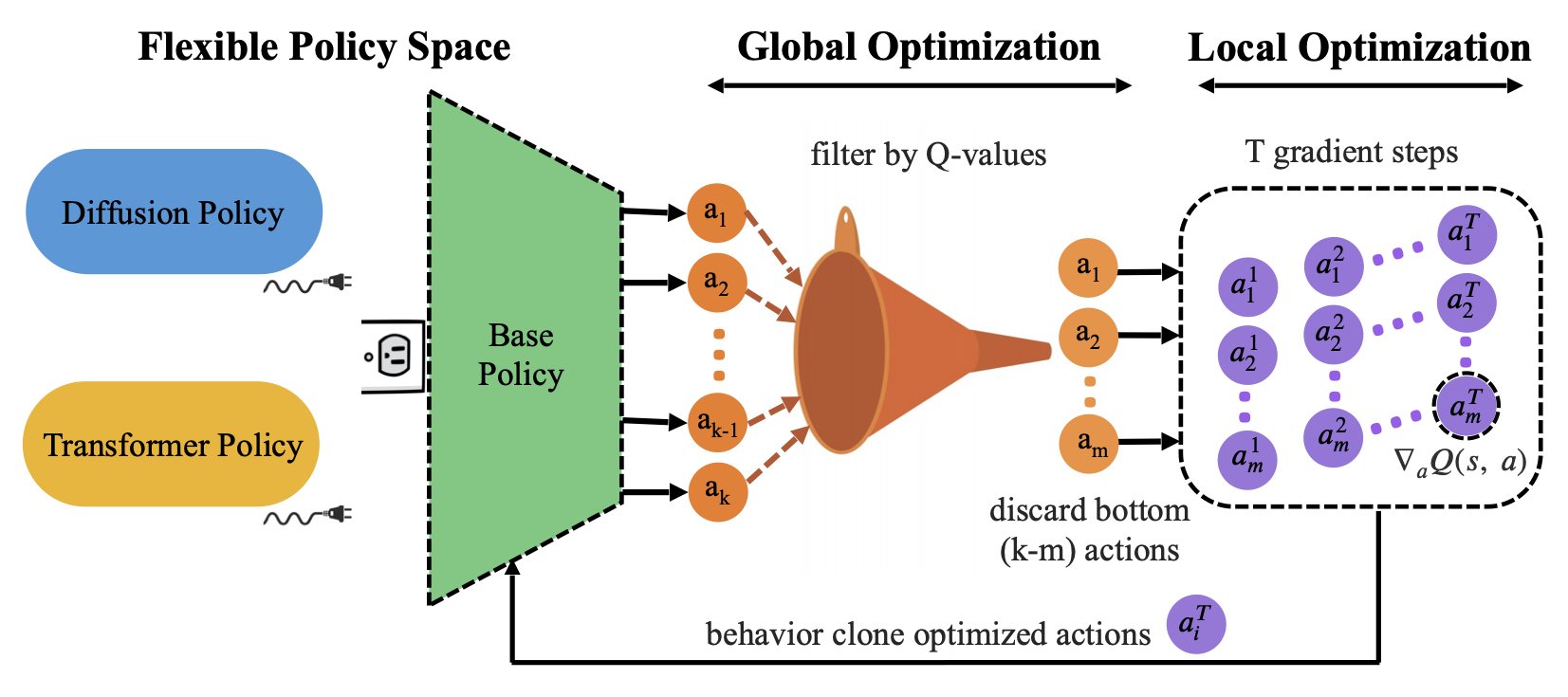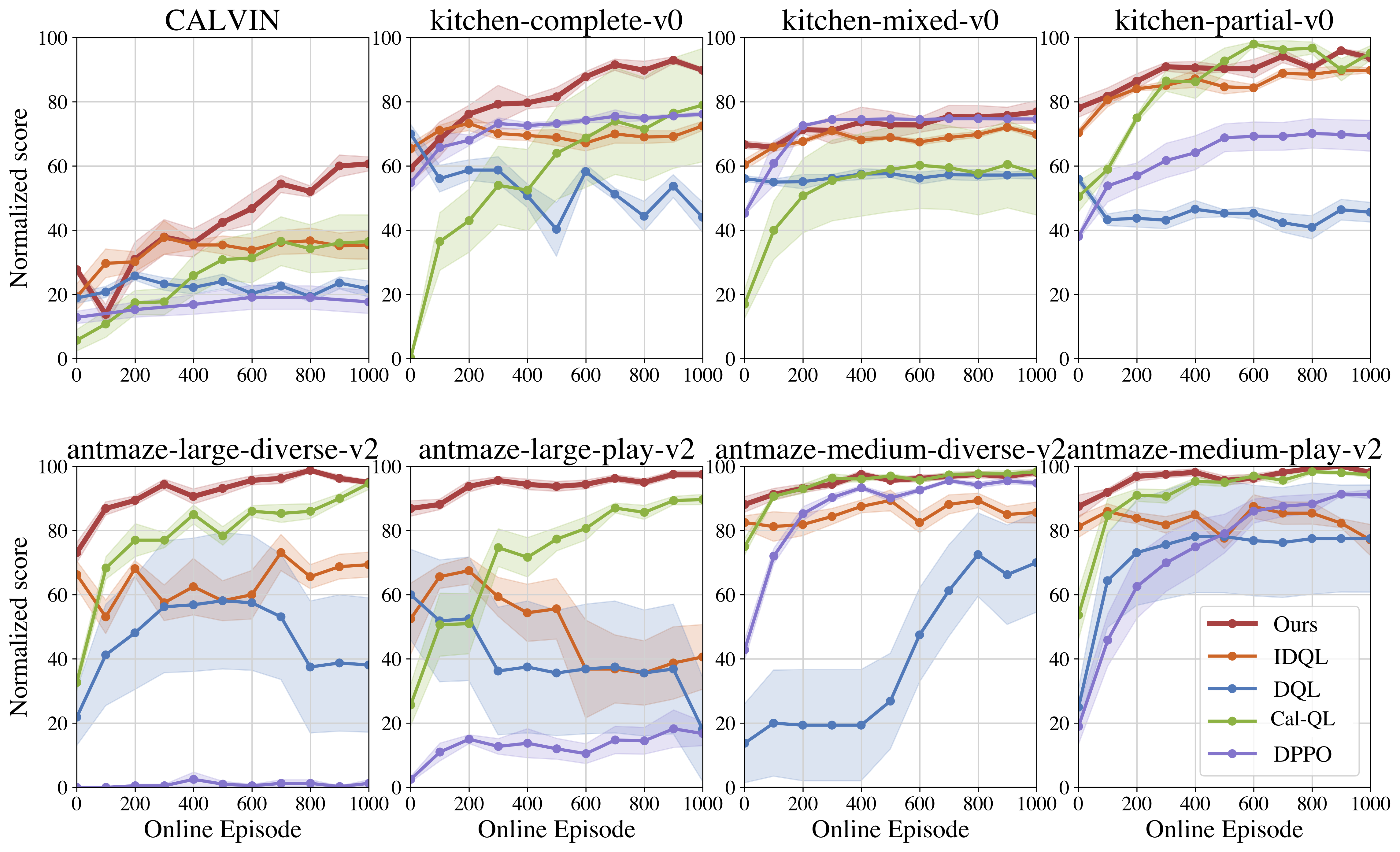Policy Agnostic RL
Fine-Tuning Multiple Policy Classes with Actor-Critic RL
Max Sobol Mark1, Tian Gao2, Georgia Gabriela Sampaio2, Mohan Kumar1, Archit Sharma2, Chelsea Finn2, Aviral Kumar1
1 Carnegie Mellon University 2 Stanford University
Max Sobol Mark1, Tian Gao2, Georgia Gabriela Sampaio2, Mohan Kumar1, Archit Sharma2, Chelsea Finn2, Aviral Kumar1
1 Carnegie Mellon University 2 Stanford University
We introduce Policy-Agnostic RL (PA-RL), a single method that fine-tunes multiple policy classes, with varying architectures and sizes. It enables sample-efficient improvement of diffusion and transformer-based autoregressive policies. The core of the method is a universal policy improvement step that decomposes improvement into two steps: obtaining "optimized" actions, and then distilling these optimized actions back into the base policy. PA-RL sets a new state of the art for offline to online RL, and it makes it possible, for the first time, to improve OpenVLA, a 7B-parameter generalist robot policy, in the real world, and without further demonstrations.
The best performing models for robotics tasks - large pre-trained transformers, diffusion policies - still perform poorly on new tasks or slightly unseen conditions. Sample-efficient RL is a recipe for improving a policy’s performance cheaply and fast.
The Actor-Critic RL architecture yields fast improvement, but has only been used with small, gaussian policies. Can we get the best of both worlds, and improve large pre-trained transformers or diffusion policies through interaction?
The best-performing policy classes are hard to train with Actor-Critic RL!
To see why, let's consider what happens when we switch the gaussian policies normally used in Actor-Critic RL with either a Diffusion Policy or an autoregressive categorical policy like OpenVLA. The Critic objective will generally look something like this:
\[ \mathcal{L}^Q = \mathbb{E}_{s, a, s' \sim \mathcal{D}} \left[ \left( Q_\theta(s, a) - (r(s, a) + \gamma \hat{Q}_\theta(s', \textcolor{red}{\pi_\phi (s')})) \right)^2 \right] \]
To optimize this objective, we only need to sample from the policy \( \color{red} \pi_\phi \). Even for policies that are very large, non-differentiable, or have different sampling mechanisms like diffusion policies, we will be able to fit a critic.
The Policy objective will look like this:
\[ \mathcal{L}^\pi = - \mathbb{E}_{s \sim \mathcal{D}} \left[ Q_\theta (s, \textcolor{red}{\pi_\phi (s)}) \right] \]
Directly optimizing this requires computing \(\nabla_\phi \textcolor{red}{\pi_\phi(s)}\). This quantity is undefined for autoregressive categorical policies like OpenVLA, because their outputs are discrete[1].
Diffusion policies, on the other hand, are fully differentiable. However, back-propagating \(\nabla_\phi \textcolor{red}{\pi_\phi(s)}\) through the denoising chain is slow and unstable, because it is a very deep computation graph[2].
Takeaway: the Policy Improvement operator is the bottleneck for improving arbitrary policies.
Policy-Agnostic RL uses a universal policy improvement step that bypasses the problems from above by transforming policy improvement into supervised learning, something most policy classes will be designed to handle.
Concretely, PA-RL decomposes the policy improvement operator into 2 steps:
 To obtain optimized actions, we first sample multiple times from the
base policy, then filter to only the top few action candidates according
to the trained critic for computational efficiency. Finally, to allow
for finer-grained action improvement, we take a few gradient steps in
the direction of value improvement
directly on the actions.
To obtain optimized actions, we first sample multiple times from the
base policy, then filter to only the top few action candidates according
to the trained critic for computational efficiency. Finally, to allow
for finer-grained action improvement, we take a few gradient steps in
the direction of value improvement
directly on the actions.
The policy distillation step simply runs supervised learning (i.e. Behavior Cloning) on the optimized actions, which makes PA-RL work well on multiple policy types.
PA-RL can be used to replace the policy improvement step in multiple RL algorithms. Our main results use PA-RL in conjunction with Cal-QL. For results with IQL and RLPD, see the paper.
We use PA-RL to efficiently improve both Diffusion Policies and OpenVLA on a real world robot for the first time. We improve OpenVLA without any further demonstrations, only making use of 1 hour of zero-shot language-conditioned trials, and 40 minutes of online RL fine-tuning on the real robot.
Zero-shot OpenVLA (40% success)
Fine-tuned OpenVLA (70% success)
BC Diffusion Policy (50% success)
Fine-tuned Diffusion Policy (90% success)
BC Diffusion Policy (50% success)
Fine-tuned Diffusion Policy (100% success)
PA-RL significantly improves learning efficiency and asymptotic performance of Cal-QL with diffusion policies. PA-RL attains both significantly better offline and online fine-tuning performance compared to other offline-to-online methods.

@article{sobolmark2024policy,
title= "Policy Agnostic RL: Offline RL and Online RL Fine-Tuning of Any Class and Backbone",
author= "Max Sobol Mark and Tian Gao and Georgia Gabriela Sampaio and Mohan Kumar Srirama and Archit Sharma and Chelsea Finn and Aviral Kumar",
year= "2024",
eprint= "2310.15145",
archivePrefix= "arXiv",
primaryClass= "cs.LG"
}